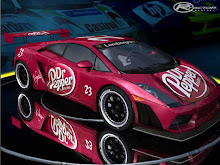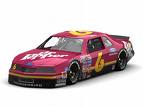Follow these instructions to experiment with colourful milk and learn about surface tension.
What you need
To do this experiment you will need
*a saucer
*milk
*food colouring (four different colours)
*detergent.
What to do
1. Fill the saucer with milk.
2. Add one drop of each food colour to the milk around the edge of the saucer.
3. Add one drop of detergent into the centre of the saucer.
What's happening:
The colours swirl and zoom around the saucer.
Milk stays together as one liquid because of surface tension. This acts like a skin and keeps the milk in a puddle. When you add the detergent, it breaks the surface tension of the milk in one spot.
The pull of the surface tension from the milk at the edge of the saucer causes the milk in the centre to move to the outside, taking the colours along with it.
The colours keep moving until the detergent stops affecting the milk.
Surface tension cause the colours to swirl.
Saturday, February 23, 2008
Amazing detergent
Posted by
Leslie
at
8:38 PM
0
comments
![]()
Labels: detergent experiment, science experiment
Sunday, February 17, 2008
Getting the bird in the cage
Draw a picture of your favorite bird on a small index card. On another card the same size, draw a cage. Now tape the two cards, drawing sides out, on opposite sides of a pen. Spin the pen between your hands or fingers. Is your bird still free or did you catch it and put it in the cage?
Why does the bird appear to be in the cage?
It appears to be caged because of how your eyes and brain work. When you see the image of the bird, your brain holds onto the image for a short time--even though the image appears and disappears quickly. The same thing happens with the image of the cage. The two images actually overlap in your brain so the bird appears to be in the cage.
The technical name for this effect is persistence. It is what lies behind every movie and every TV program that you see.
Posted by
Leslie
at
8:20 PM
1 comments
![]()
Labels: bird in the cage, science experiment
Tuesday, February 12, 2008
Mobius strips
Cut a 5-cm strip lengthwise from a newspaper. Holding the strip out straight, give it a half twist (180 degrees) and glue the two ends together. Take a texta and carefully draw a line along the centre of the strip. Where do you end up? Is the line drawn on the inside or outside of the paper? Now cut the strip along the line you drew. How many chains do you get? Now try cutting a half-twist strip, one-third of the way from one edge.
Your piece of paper is called a Mobius strip, which is a shape described by a branch of mathematics called topology. When you twisted your strip, the inside and outside became one continuous surface. And when you cut the strip, it became one longer chain but still had only one continuous surface.
Try the experiment again and give the paper a full twist. Then try one and a half twists, and see what happens.
Posted by
Leslie
at
8:15 PM
0
comments
![]()
Labels: mobius strip, science experiment









